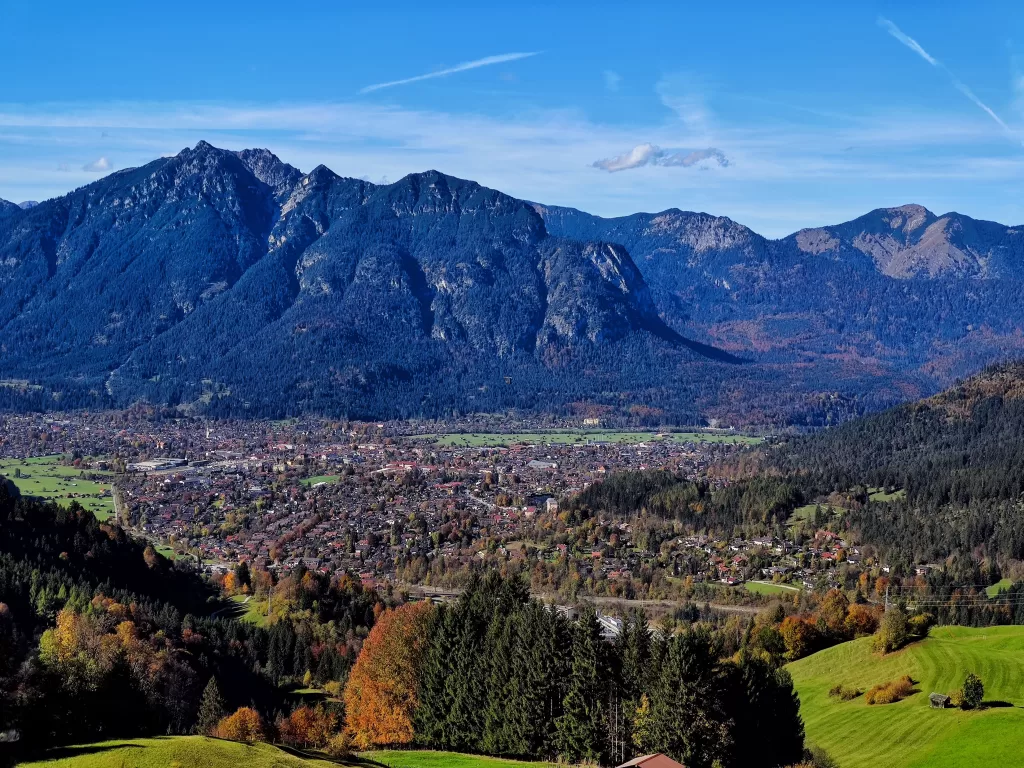 Located at the border of Germany and surrounded by sky-touching mountains, Garmisch-Partenkirchen is a town that was formed by merging two smaller towns: Garmisch and Partenkirchen. Known for hosting the 1936 Winter Olympics, it’s a popular spot for winter sports. I’m not much of a skier, but that didn’t stop my husband and me from enjoying the mountains when we visited in October 2022.
Located at the border of Germany and surrounded by sky-touching mountains, Garmisch-Partenkirchen is a town that was formed by merging two smaller towns: Garmisch and Partenkirchen. Known for hosting the 1936 Winter Olympics, it’s a popular spot for winter sports. I’m not much of a skier, but that didn’t stop my husband and me from enjoying the mountains when we visited in October 2022.
Best time to visit: Between late Spring to early Autumn and Winter
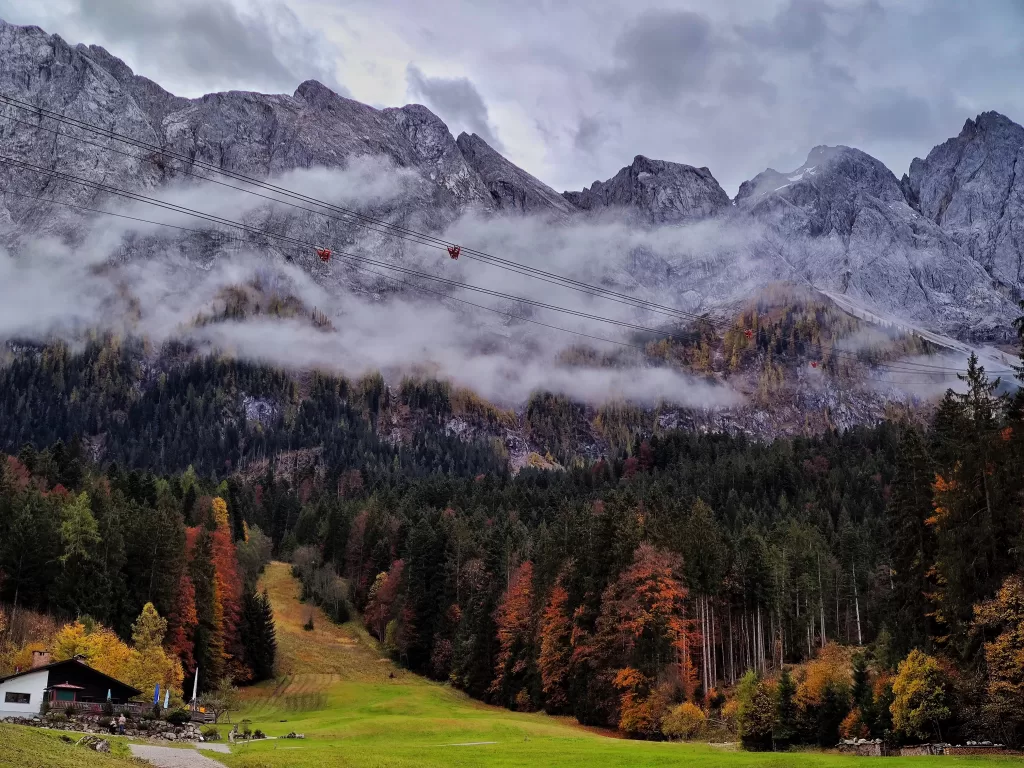 The area offers a lot of options for travelers, from various hiking paths to ski slopes. Since I’ve only been there once, I’ll focus on sharing my own experience.
The area offers a lot of options for travelers, from various hiking paths to ski slopes. Since I’ve only been there once, I’ll focus on sharing my own experience.
We planned a three-day trip to Garmisch-Partenkirchen last October (2022). Inspired by the German-learning cartoon “Harry – gefangen in der Zeit,” I was eager to go up to the Zugspitze, while my husband looked forward to a nice autumn hike.
We started our trip from Munich, similar to our previous visit to Schloss Linderhof. Normally, you can take a direct train (RB6) from München Hbf (Munich Main Station) to Garmisch-Partenkirchen. However, due to a past train accident, we had to take a train and then switch to a bus. The whole trip took about one and a half hours. It’s always a good idea to double-check the latest info on Deutsche Bahn’s Website.
Day 1: A Journey to Snow-Capped Peaks and an Enchanting Lake
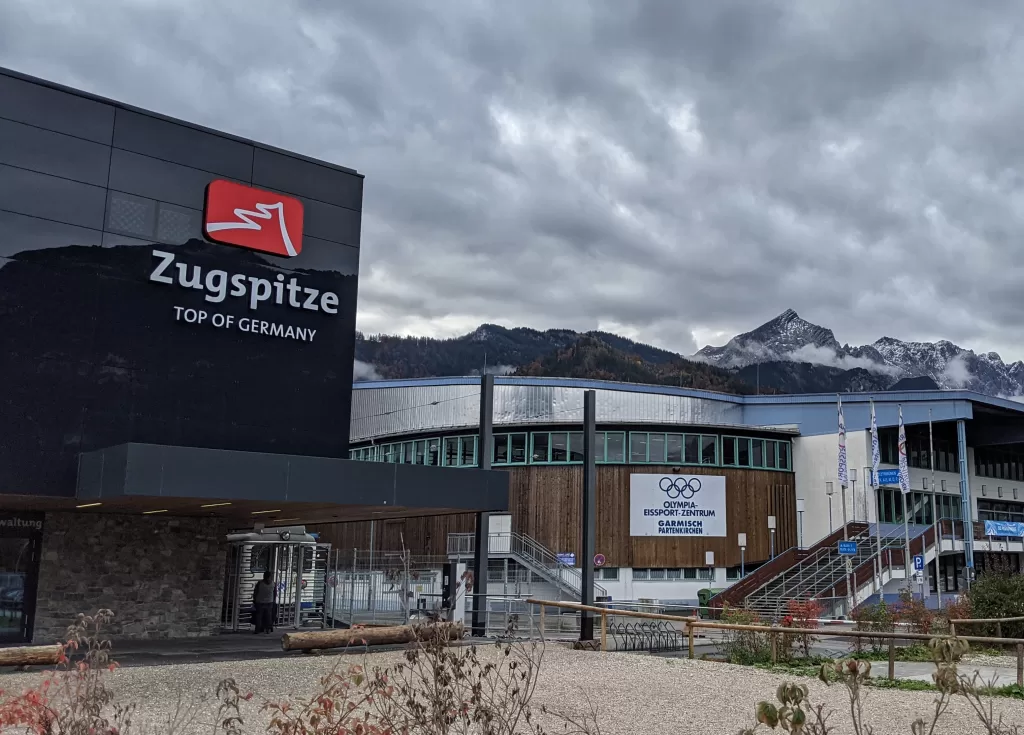 Upon our arrival in Garmisch, the attraction of the mountains was too strong to ignore. Given their distance from the town, we took specialized mountain trains, specifically the Bayerische Zugspitzbahn Bergbahn, to reach our destination. Conveniently located near the train station, the facility is hard to miss: Just look for the imposing structure bearing the sign “Zugspitze, Top of Germany.”
Upon our arrival in Garmisch, the attraction of the mountains was too strong to ignore. Given their distance from the town, we took specialized mountain trains, specifically the Bayerische Zugspitzbahn Bergbahn, to reach our destination. Conveniently located near the train station, the facility is hard to miss: Just look for the imposing structure bearing the sign “Zugspitze, Top of Germany.”
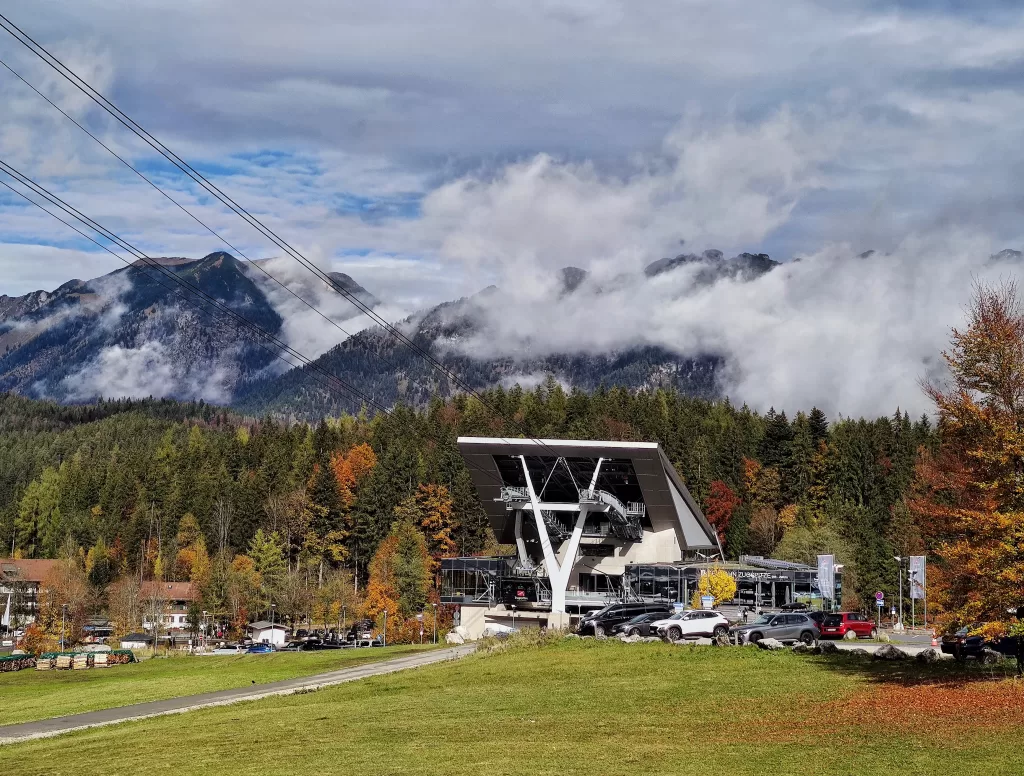 The station offers a variety of ticket options, including those that stop at different towns along the way. If your plan is straightforward – up the mountain and back – a round-trip ticket is the most practical choice, as I’ve mentioned in my other blogs. We, however, decided to make a stop at Eibsee for lunch and a brief rest. This is also the point where you can switch to a cable car that takes you directly to Zugspitze. We chose the cogwheel train to Zugspitzplatt, a platform slightly lower than the summit. For detailed pricing, you can visit Zugspitze’s official website.
The station offers a variety of ticket options, including those that stop at different towns along the way. If your plan is straightforward – up the mountain and back – a round-trip ticket is the most practical choice, as I’ve mentioned in my other blogs. We, however, decided to make a stop at Eibsee for lunch and a brief rest. This is also the point where you can switch to a cable car that takes you directly to Zugspitze. We chose the cogwheel train to Zugspitzplatt, a platform slightly lower than the summit. For detailed pricing, you can visit Zugspitze’s official website.
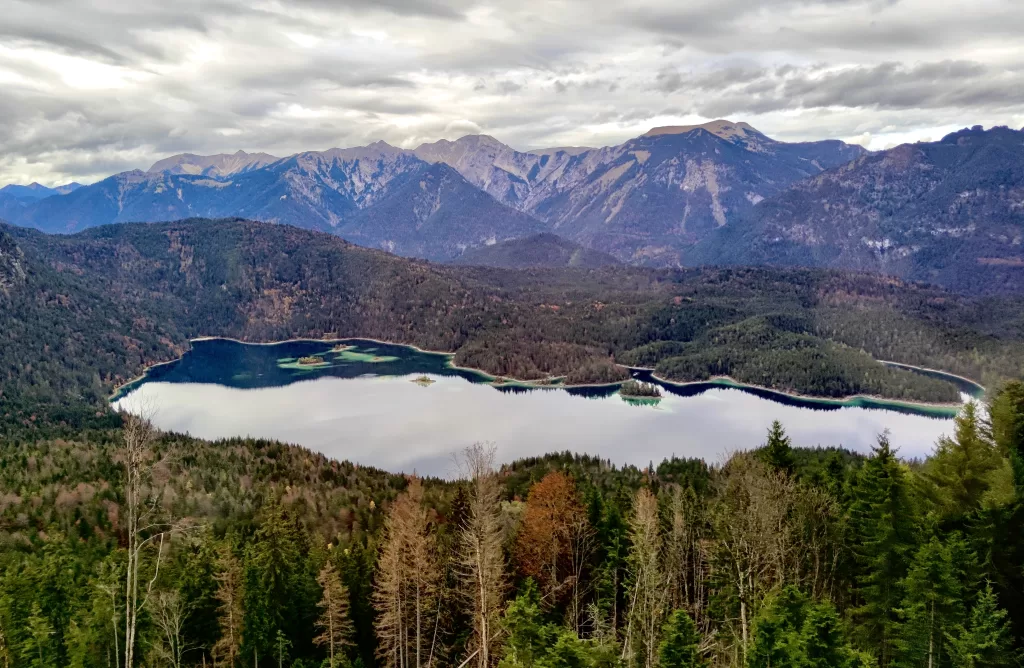 A quick tip for those ascending the mountain: Whether you’re on the cable car or the cogwheel train, try to sit on the right side. This will give you a fleeting yet captivating glimpse of Eibsee, a lake that shimmers in shades of emerald and pine green, depending on the sunlight.
A quick tip for those ascending the mountain: Whether you’re on the cable car or the cogwheel train, try to sit on the right side. This will give you a fleeting yet captivating glimpse of Eibsee, a lake that shimmers in shades of emerald and pine green, depending on the sunlight.
Reaching Zugspitzplatt, at an elevation of 2600 meters, we were greeted by a blanket of snow, even in October. The snow’s glare was intense, making sunglasses a necessity. While you can purchase them there, they come at a premium. So, it’s advisable to come prepared, especially if you’re venturing to such high altitudes.
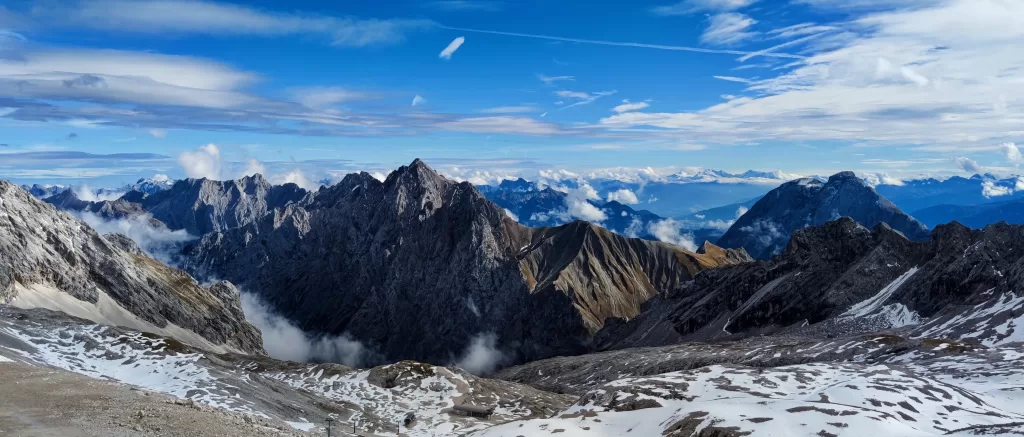
The thrill of encountering snow so early in the year was exhilarating, to say the least. However, the location’s lower elevation meant our views were somewhat obstructed by surrounding peaks. After exploring the limited area, we retreated to one of the available cafes to warm up.
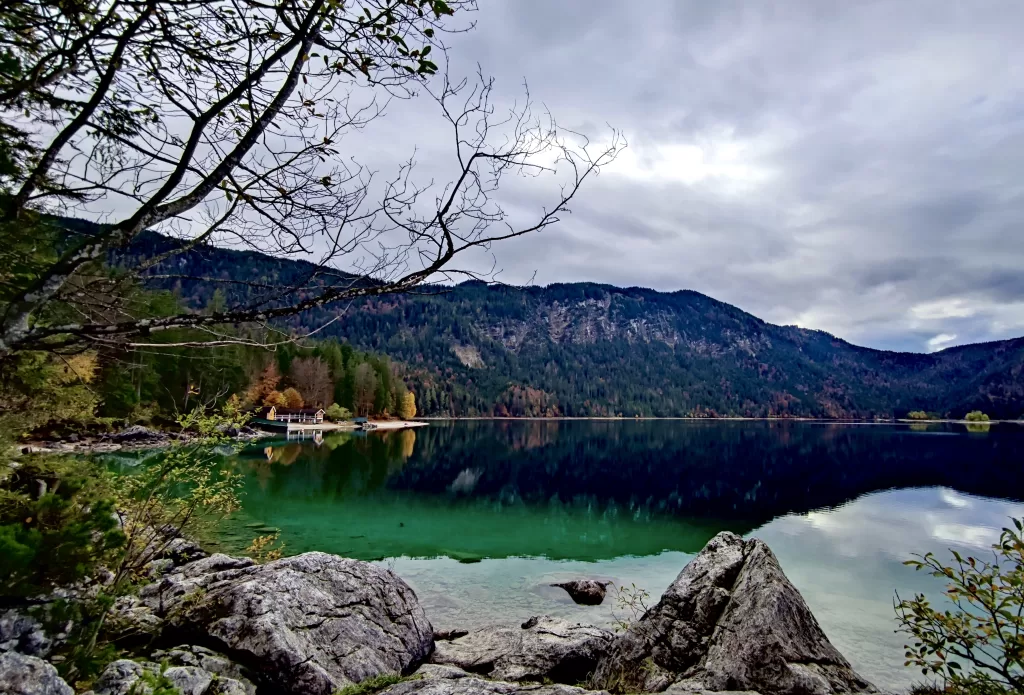 The weather wasn’t particularly cooperative that day, offering only brief moments of sunshine before clouds took over. Yet, even under such conditions, Eibsee was captivating. Descending to the lake, its crystalline waters felt almost gem-like, transforming from Emerald to liquid at the touch. While the lake may appear small from a distance, it’s quite expansive up close. If time permits, I highly recommend venturing to its small islands.
The weather wasn’t particularly cooperative that day, offering only brief moments of sunshine before clouds took over. Yet, even under such conditions, Eibsee was captivating. Descending to the lake, its crystalline waters felt almost gem-like, transforming from Emerald to liquid at the touch. While the lake may appear small from a distance, it’s quite expansive up close. If time permits, I highly recommend venturing to its small islands.
Day 2: Hiking Adventure
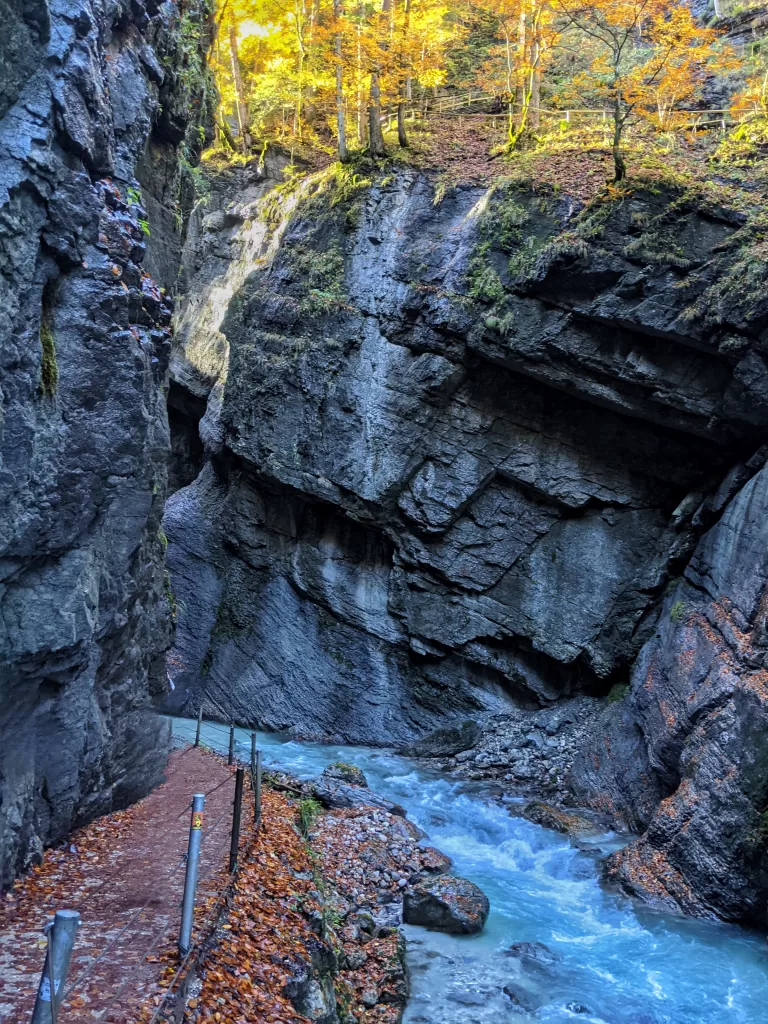 Choosing a hiking trail in the Garmisch region is no small feat, given the plethora of options that range from beginner-friendly to extremely challenging. Initially, I was drawn to the idea of a half-hill hike to the Alpspitze, but that would have required a cable car ride, which we decided to skip. After consulting various maps and receiving recommendations from the friendly staff at the Tourist Information Center, we settled on a route that would take us through Partnachklamm (Partnach Gorge), up a modest mountain, and then back down the other side.
Choosing a hiking trail in the Garmisch region is no small feat, given the plethora of options that range from beginner-friendly to extremely challenging. Initially, I was drawn to the idea of a half-hill hike to the Alpspitze, but that would have required a cable car ride, which we decided to skip. After consulting various maps and receiving recommendations from the friendly staff at the Tourist Information Center, we settled on a route that would take us through Partnachklamm (Partnach Gorge), up a modest mountain, and then back down the other side.
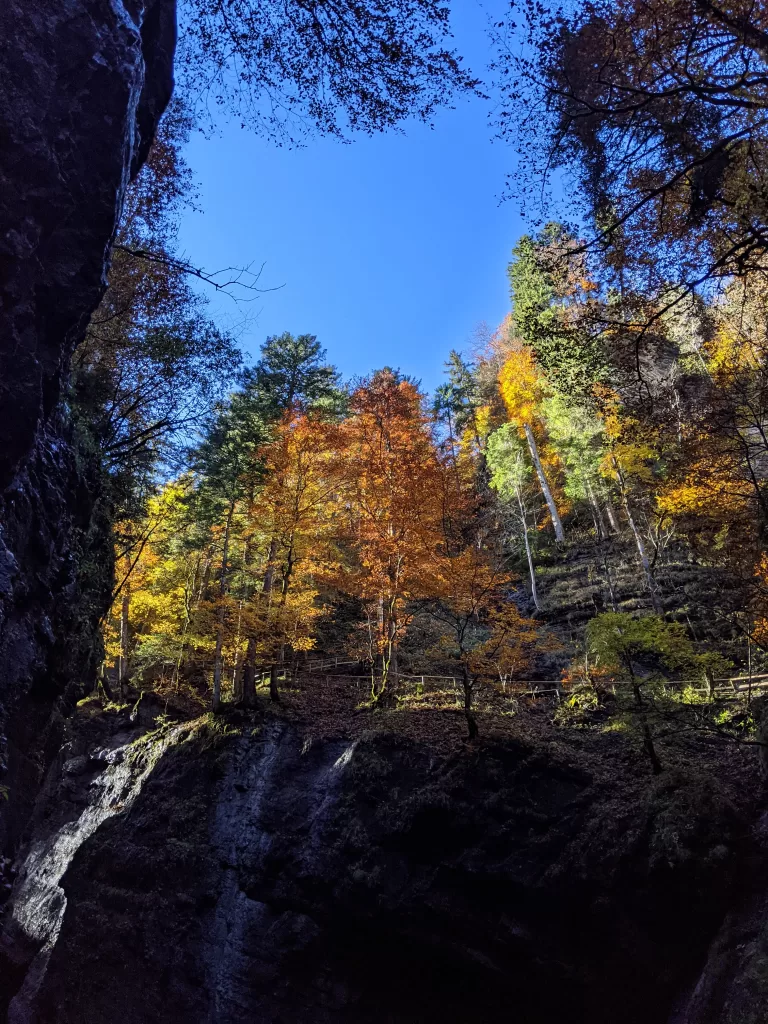 Partnachklamm had been on my husband’s wish list for a year, and we finally seized the opportunity to visit. While gorges are commonplace in my father’s hometown of Chongqing, China, they are a rare sight in Europe. The roaring water carving its way through the rocky valley was a spectacle in itself, but what captivated me even more was the autumnal glow of the trees reflecting off the rocks – creating a stunning contrast of scenery.
Partnachklamm had been on my husband’s wish list for a year, and we finally seized the opportunity to visit. While gorges are commonplace in my father’s hometown of Chongqing, China, they are a rare sight in Europe. The roaring water carving its way through the rocky valley was a spectacle in itself, but what captivated me even more was the autumnal glow of the trees reflecting off the rocks – creating a stunning contrast of scenery.
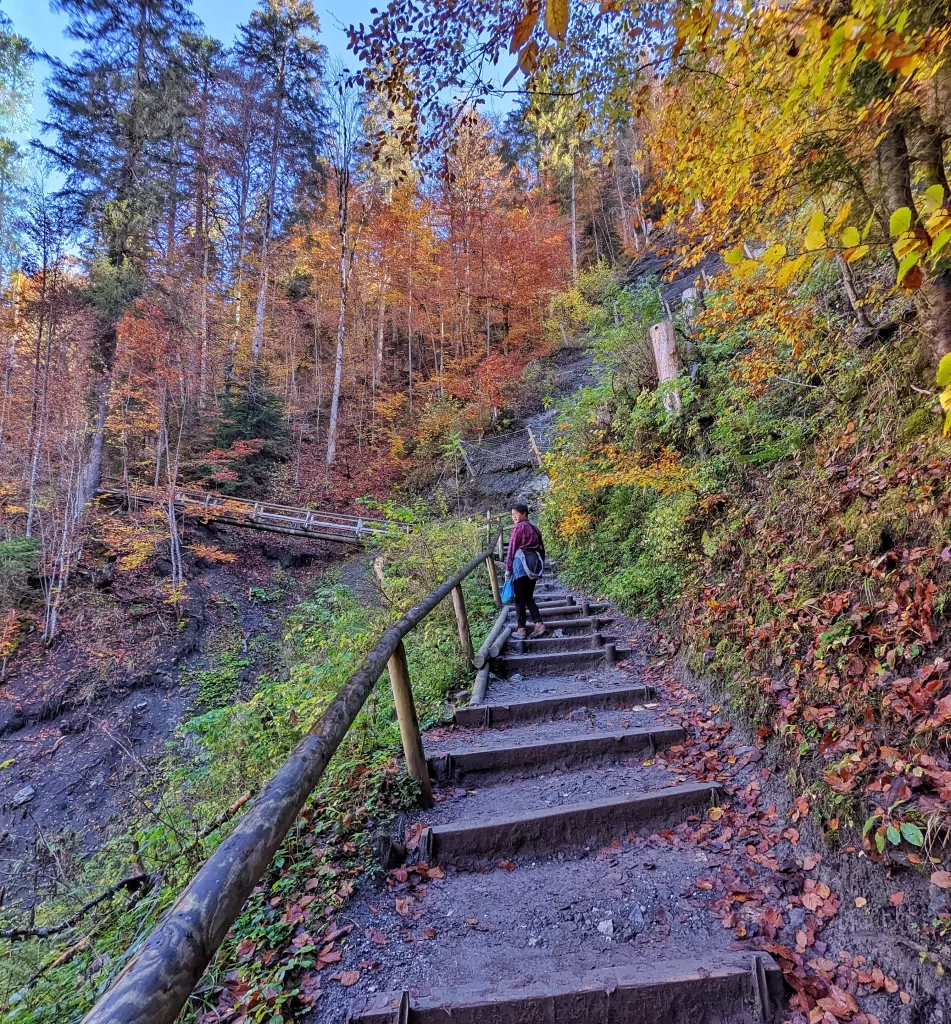 The ascent began after the gorge, and the trail exceeded my expectations. Initially, the path consisted of stairs and wooden bridges, eventually leveling out to a highland where people actually reside in quaint wooden homes. We took a short break at a Hütte, enjoying some beer and cake to recharge before continuing our hike.
The ascent began after the gorge, and the trail exceeded my expectations. Initially, the path consisted of stairs and wooden bridges, eventually leveling out to a highland where people actually reside in quaint wooden homes. We took a short break at a Hütte, enjoying some beer and cake to recharge before continuing our hike.
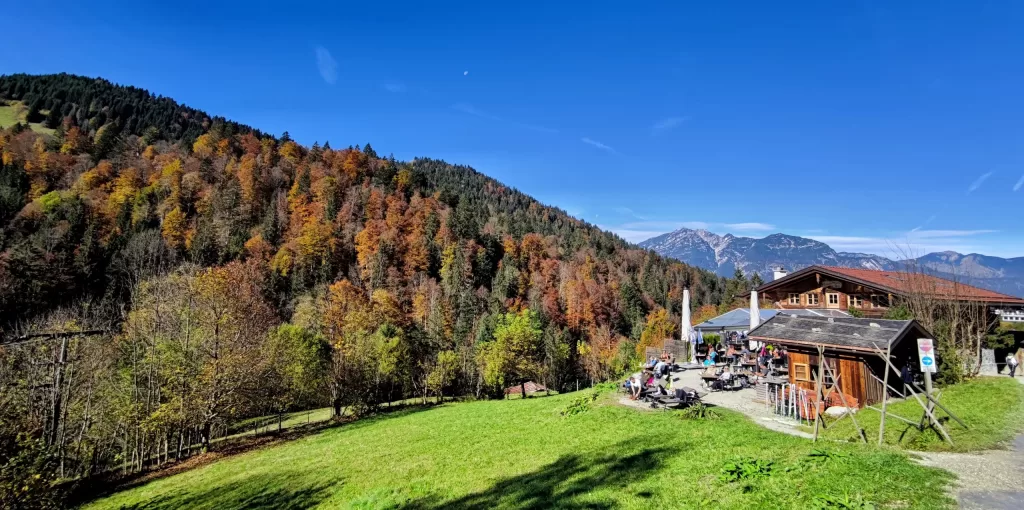
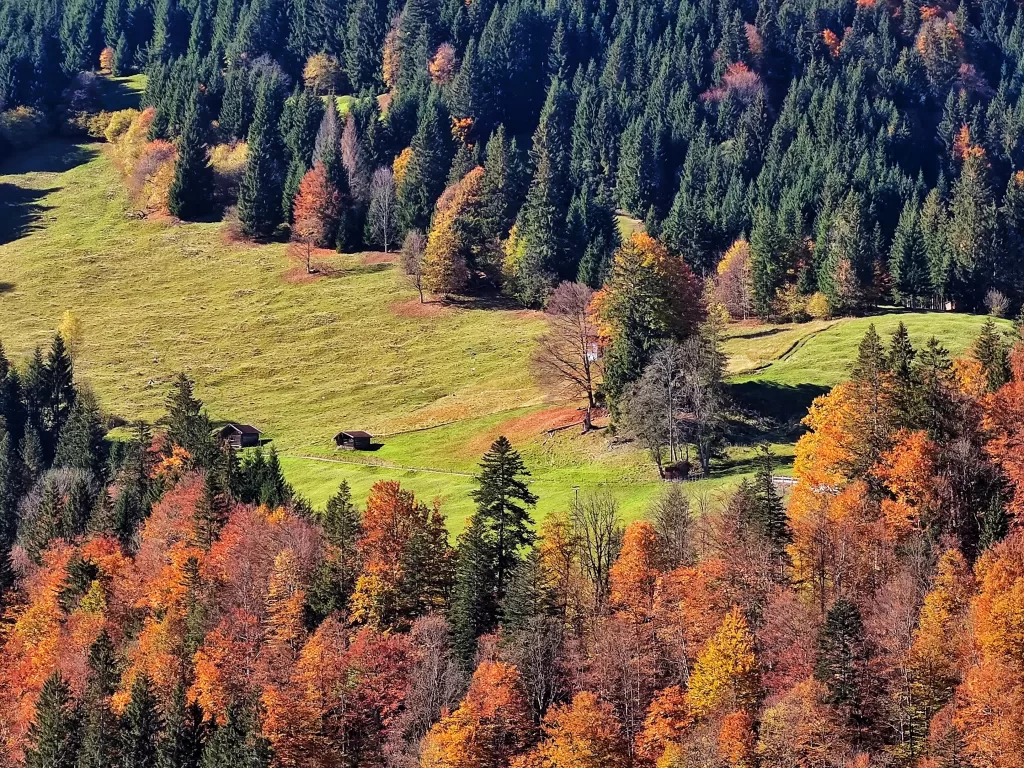
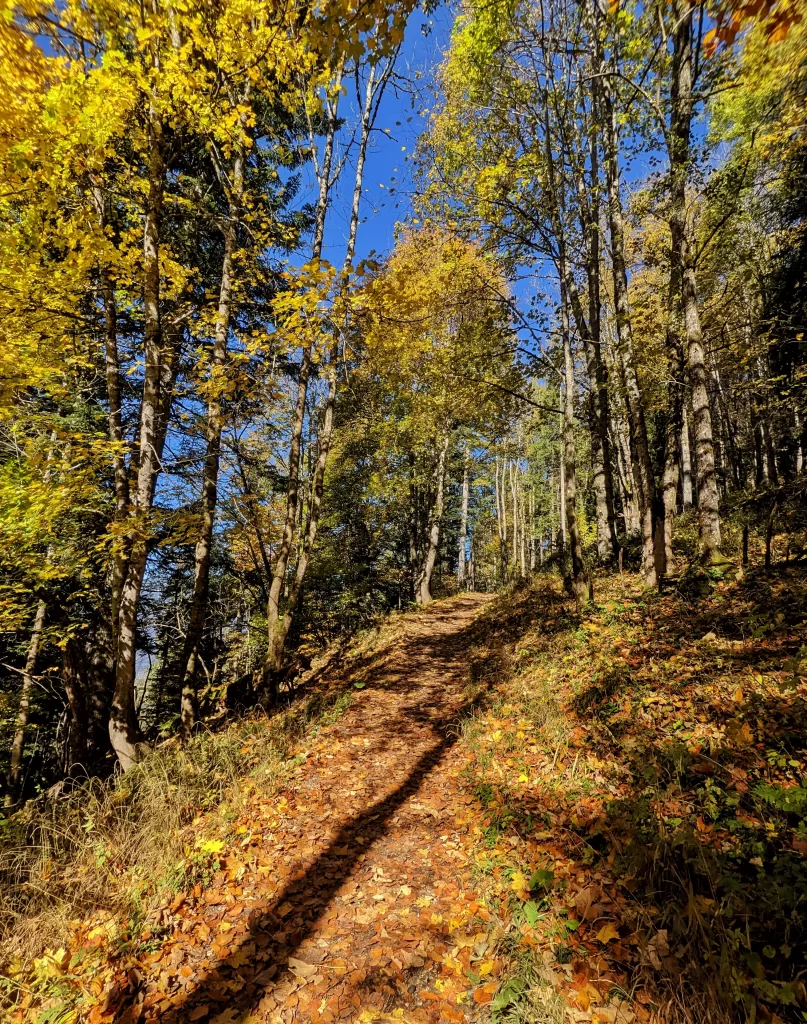 Beyond this highland, the trail became steeper and transitioned into a more traditional mountain path, complete with soil and fallen autumn leaves. The weather was exceptionally clear, with a blue sky and radiant sunshine illuminating the vivid colors of the trees. In the Alpine region, evergreen pine trees dominate the landscape, but the deciduous trees were ablaze in shades of yellow and red. It was as if nature’s paintbrush had swept across the mountains, turning everything it touched to gold.
Beyond this highland, the trail became steeper and transitioned into a more traditional mountain path, complete with soil and fallen autumn leaves. The weather was exceptionally clear, with a blue sky and radiant sunshine illuminating the vivid colors of the trees. In the Alpine region, evergreen pine trees dominate the landscape, but the deciduous trees were ablaze in shades of yellow and red. It was as if nature’s paintbrush had swept across the mountains, turning everything it touched to gold.
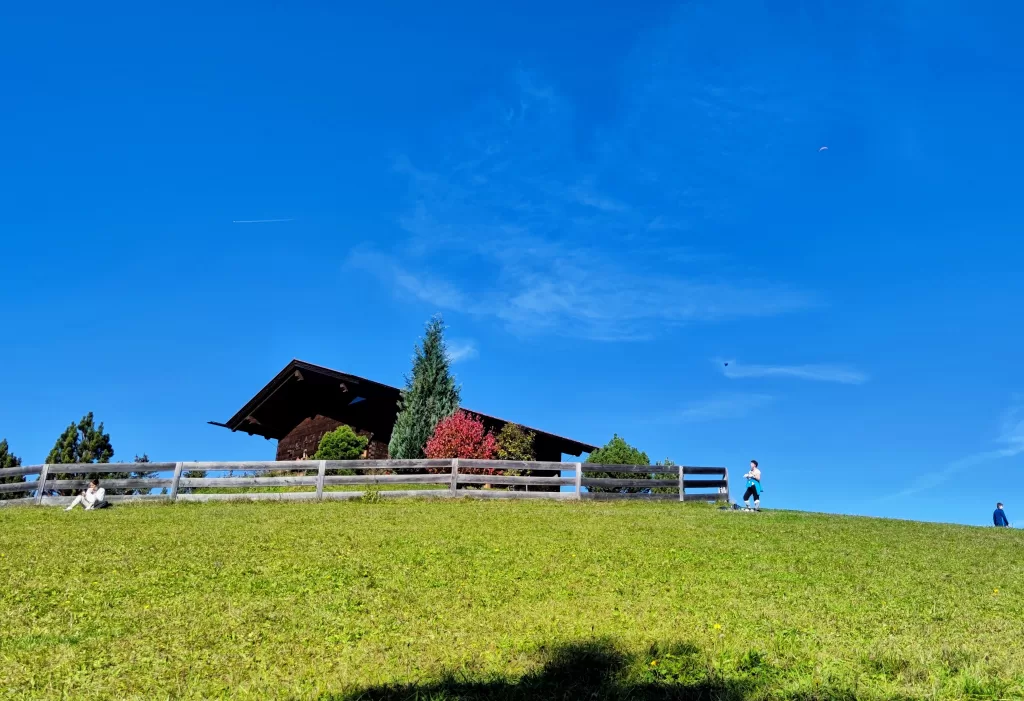 The final stretch of the climb felt endless and was physically taxing. It was humbling to be overtaken by both the elderly and young children who seemed unfazed by the ascent. At the summit, we found a private wooden house, which made me ponder the idea of privacy in such a touristy area. If I were to build a house, it would be far distant from snooping eyes.
The final stretch of the climb felt endless and was physically taxing. It was humbling to be overtaken by both the elderly and young children who seemed unfazed by the ascent. At the summit, we found a private wooden house, which made me ponder the idea of privacy in such a touristy area. If I were to build a house, it would be far distant from snooping eyes.
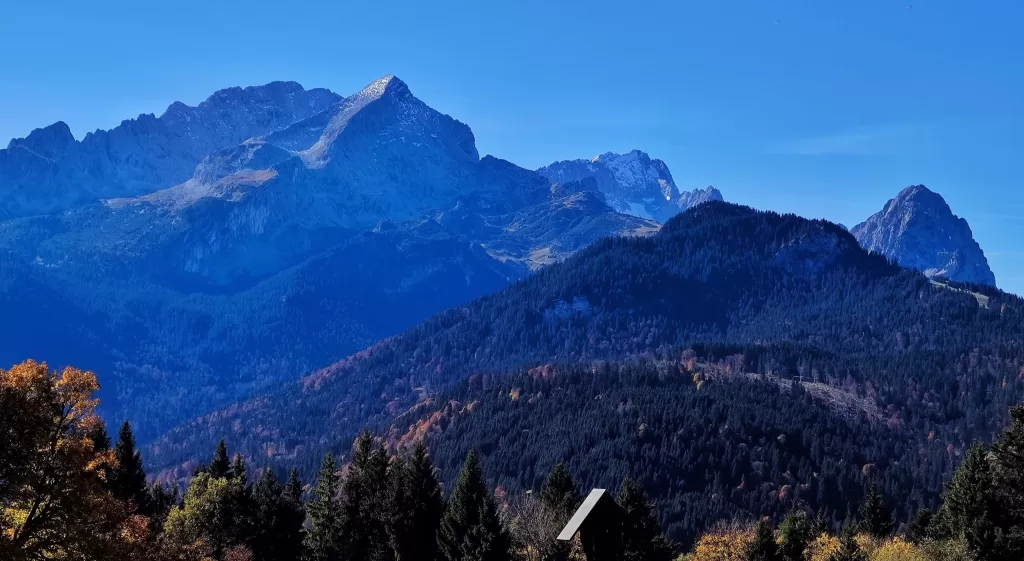
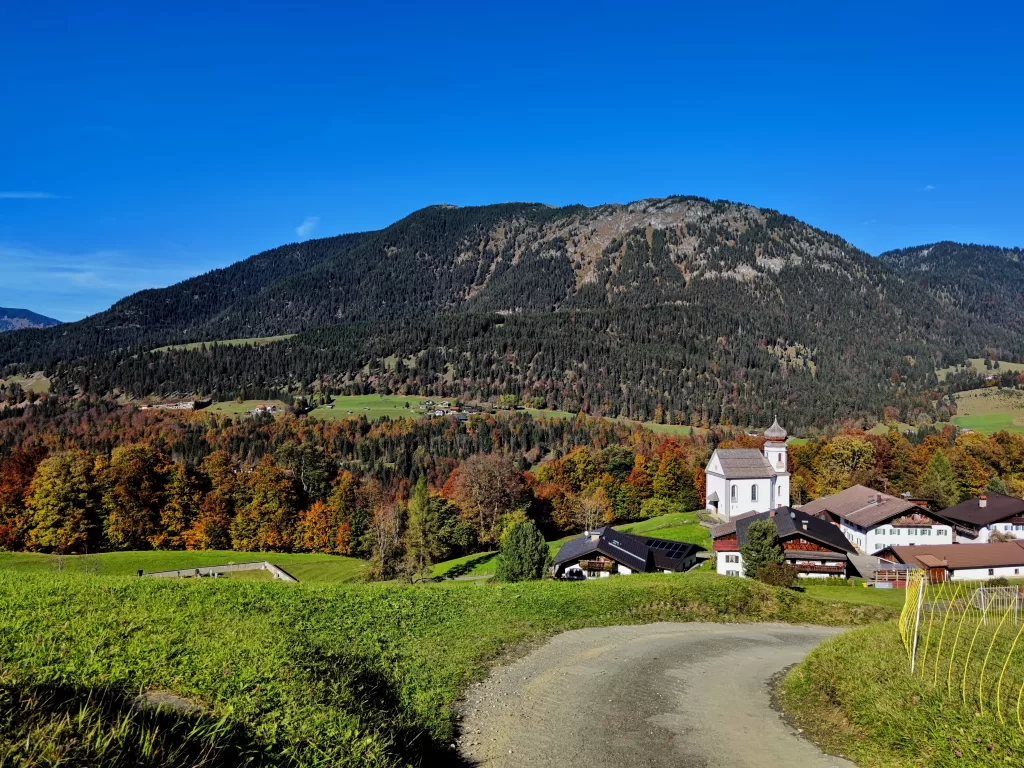 As we began our descent, the view transformed. We could now see the entirety of Garmisch-Partenkirchen and the surrounding mountains. I regretted not bringing hiking sticks, as the downward slope was even more treacherous than the climb. My feet slipped several times, causing me to walk cautiously along the edge or even on the grass. Eventually, we reached the charming village of Wamberg, complete with a historic church and a single, century-old restaurant, Berggasthof Wamberg, frequently visited by both hikers and locals. As the sun dipped below the horizon, softening the colors around us, we made our way back to town, marking the end of our hiking adventure.
As we began our descent, the view transformed. We could now see the entirety of Garmisch-Partenkirchen and the surrounding mountains. I regretted not bringing hiking sticks, as the downward slope was even more treacherous than the climb. My feet slipped several times, causing me to walk cautiously along the edge or even on the grass. Eventually, we reached the charming village of Wamberg, complete with a historic church and a single, century-old restaurant, Berggasthof Wamberg, frequently visited by both hikers and locals. As the sun dipped below the horizon, softening the colors around us, we made our way back to town, marking the end of our hiking adventure.
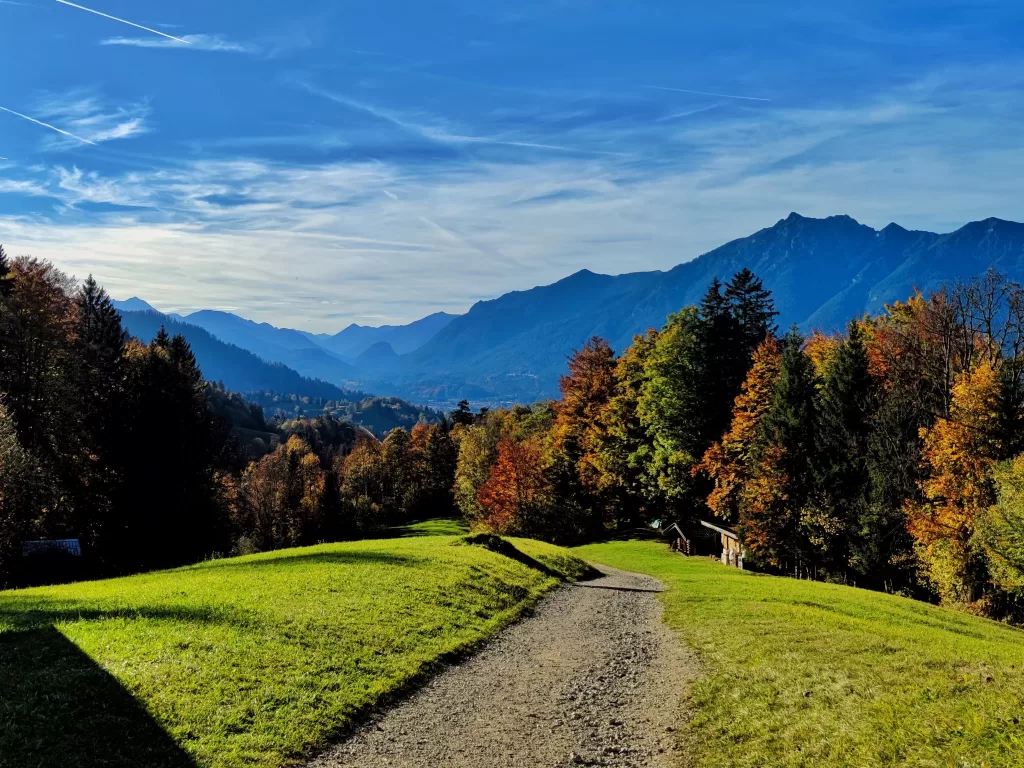 Our journey to Garmisch-Partenkirchen was nothing short of enriching. From ascending the towering Zugspitze to hiking through the scenic Partnach Gorge, the trip offered a diverse array of experiences that cater to both the adventurous and those seeking tranquility. Although our time there was limited, the memories we forged are indelible. If you find yourself in this corner of Germany, a visit is highly recommended for a taste of Alpine splendor.
Our journey to Garmisch-Partenkirchen was nothing short of enriching. From ascending the towering Zugspitze to hiking through the scenic Partnach Gorge, the trip offered a diverse array of experiences that cater to both the adventurous and those seeking tranquility. Although our time there was limited, the memories we forged are indelible. If you find yourself in this corner of Germany, a visit is highly recommended for a taste of Alpine splendor.
The Alpine Wonders of Garmisch-Partenkirchen: Hiking, Zugspitze, and More

Located at the border of Germany and surrounded by sky-touching mountains, Garmisch-Partenkirchen is a town that was formed by merging two smaller towns: Garmisch and Partenkirchen. Known for hosting the 1936 Winter Olympics, it’s a popular spot for winter sports. I’m not much of a skier, but that didn’t stop my husband and me from enjoying the mountains when we visited in October 2022.
Best time to visit: Between late Spring to early Autumn and Winter
The area offers a lot of options for travelers, from various hiking paths to ski slopes. Since I’ve only been there once, I’ll focus on sharing my own experience.
We planned a three-day trip to Garmisch-Partenkirchen last October (2022). Inspired by the German-learning cartoon “Harry – gefangen in der Zeit,” I was eager to go up to the Zugspitze, while my husband looked forward to a nice autumn hike.

We started our trip from Munich, similar to our previous visit to Schloss Linderhof. Normally, you can take a direct train (RB6) from München Hbf (Munich Main Station) to Garmisch-Partenkirchen. However, due to a past train accident, we had to take a train and then switch to a bus. The whole trip took about one and a half hours. It’s always a good idea to double-check the latest info on Deutsche Bahn’s Website.
Day 1: A Journey to Snow-Capped Peaks and an Enchanting Lake
Upon our arrival in Garmisch, the attraction of the mountains was too strong to ignore. Given their distance from the town, we took specialized mountain trains, specifically the Bayerische Zugspitzbahn Bergbahn, to reach our destination. Conveniently located near the train station, the facility is hard to miss: Just look for the imposing structure bearing the sign “Zugspitze, Top of Germany.”

The station offers a variety of ticket options, including those that stop at different towns along the way. If your plan is straightforward – up the mountain and back – a round-trip ticket is the most practical choice, as I’ve mentioned in my other blogs. We, however, decided to make a stop at Eibsee for lunch and a brief rest. This is also the point where you can switch to a cable car that takes you directly to Zugspitze. We chose the cogwheel train to Zugspitzplatt, a platform slightly lower than the summit. For detailed pricing, you can visit Zugspitze’s official website.

A quick tip for those ascending the mountain: Whether you’re on the cable car or the cogwheel train, try to sit on the right side. This will give you a fleeting yet captivating glimpse of Eibsee, a lake that shimmers in shades of emerald and pine green, depending on the sunlight.

Reaching Zugspitzplatt, at an elevation of 2600 meters, we were greeted by a blanket of snow, even in October. The snow’s glare was intense, making sunglasses a necessity. While you can purchase them there, they come at a premium. So, it’s advisable to come prepared, especially if you’re venturing to such high altitudes.

The thrill of encountering snow so early in the year was exhilarating, to say the least. However, the location’s lower elevation meant our views were somewhat obstructed by surrounding peaks. After exploring the limited area, we retreated to one of the available cafes to warm up.
The weather wasn’t particularly cooperative that day, offering only brief moments of sunshine before clouds took over. Yet, even under such conditions, Eibsee was captivating. Descending to the lake, its crystalline waters felt almost gem-like, transforming from Emerald to liquid at the touch. While the lake may appear small from a distance, it’s quite expansive up close. If time permits, I highly recommend venturing to its small islands.

Day 2: Hiking Adventure
Choosing a hiking trail in the Garmisch region is no small feat, given the plethora of options that range from beginner-friendly to extremely challenging. Initially, I was drawn to the idea of a half-hill hike to the Alpspitze, but that would have required a cable car ride, which we decided to skip. After consulting various maps and receiving recommendations from the friendly staff at the Tourist Information Center, we settled on a route that would take us through Partnachklamm (Partnach Gorge), up a modest mountain, and then back down the other side.

Partnachklamm had been on my husband’s wish list for a year, and we finally seized the opportunity to visit. While gorges are commonplace in my father’s hometown of Chongqing, China, they are a rare sight in Europe. The roaring water carving its way through the rocky valley was a spectacle in itself, but what captivated me even more was the autumnal glow of the trees reflecting off the rocks – creating a stunning contrast of scenery.

The ascent began after the gorge, and the trail exceeded my expectations. Initially, the path consisted of stairs and wooden bridges, eventually leveling out to a highland where people actually reside in quaint wooden homes.

We took a short break at a Hütte, enjoying some beer and cake to recharge before continuing our hike.

Beyond this highland, the trail became steeper and transitioned into a more traditional mountain path, complete with soil and fallen autumn leaves. The weather was exceptionally clear, with a blue sky and radiant sunshine illuminating the vivid colors of the trees.

In the Alpine region, evergreen pine trees dominate the landscape, but the deciduous trees were ablaze in shades of yellow and red. It was as if nature’s paintbrush had swept across the mountains, turning everything it touched to gold.

The final stretch of the climb felt endless and was physically taxing. It was humbling to be overtaken by both the elderly and young children who seemed unfazed by the ascent. At the summit, we found a private wooden house, which made me ponder the idea of privacy in such a touristy area. If I were to build a house, it would be far distant from snooping eyes.


As we began our descent, the view transformed. We could now see the entirety of Garmisch-Partenkirchen and the surrounding mountains.

I regretted not bringing hiking sticks, as the downward slope was even more treacherous than the climb. My feet slipped several times, causing me to walk cautiously along the edge or even on the grass. Eventually, we reached the charming village of Wamberg, complete with a historic church and a single, century-old restaurant, Berggasthof Wamberg, frequently visited by both hikers and locals. As the sun dipped below the horizon, softening the colors around us, we made our way back to town, marking the end of our hiking adventure.

Our journey to Garmisch-Partenkirchen was nothing short of enriching. From ascending the towering Zugspitze to hiking through the scenic Partnach Gorge, the trip offered a diverse array of experiences that cater to both the adventurous and those seeking tranquility. Although our time there was limited, the memories we forged are indelible. If you find yourself in this corner of Germany, a visit is highly recommended for a taste of Alpine splendor.